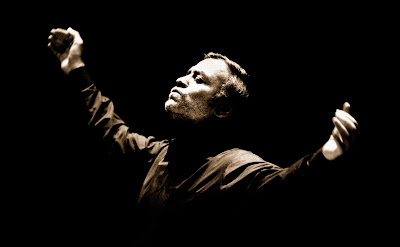 |
| Valery Gergiev rises to the occasion. |
The concert marked the second of Mr. Gergiev's complete Mahler cycle in New York this season. When the schedule was announced, the symphonies looked to be in random order: 6, 2, 8, 5, 1, 4. However, hearing the Second only a few days after Sunday's performance of the Sixth, Mr. Gergiev's intentions are clear. In his version of the Mahler-verse, the tragic protagonist of the Sixth, felled by the hammer blow of fate, is resurrected and elevated to heaven in the Second.
The journey takes five movements. As he so often does, Mr. Gergiev chose power over precision, slamming the notes out in a rough-but-ready fashion, urging the orchestra forward with a shake of his shoulders or a cryptic gesture from his baton-less hands. This was exciting music-making, with a raw, unpolished quality that adds to the pathos of Mahler's work.
The Resurrection Symphony was originally conceived as Totenfeier ("Funeral Rite") a tone poem in one movement. It opens memorably, with a fragmentary theme growled by the basses. The brass come blaring in, pouring out their grief. But as with the Sunday performance of the Sixth, Mr. Gergiev seems more concerned with bringing out the rage in Mahler than the hair-tearing grief.
The remaining four movements were played in quick succession. The strings took the spotlight for the Ländler, an Austrian peasant dance that appears frequently in Mahler. The Scherzo depicted the horrors of life with weird rhythms and ominous bangs and clicks from the percussion section. Mezzo-soprano Olga Borodina stood up to sing Urlicht ("Primeval Light") a Wunderhorn song which here serves a similar function to the bass solo in Beethoven's Ninth. Here, sets the stage for the choral redemption to come.
Ms. Borodina sang with a cool approach entirely appropriate to a voice from above. The thunder returned as the brass and percussion hammered out the opening of the finale, again recalling Beethoven. The stage door opened for an offstage brass passage that depicted the last trumpet. Another Mahlerian march narrated the dead rising from their graves. Finally, soprano Anastasia Kalagina and the double chorus joined Ms. Borodina in the symphony's final pages. A flood of bright shining sound rushed from the stage. And like the dead themselves, the audience rose, transcended.




